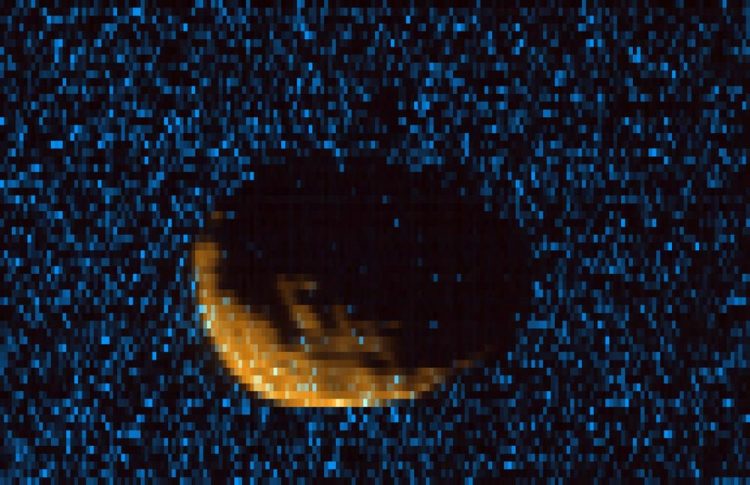MAVEN observes Mars moon Phobos in the mid- and far-ultraviolet

Phobos as observed by MAVEN's Imaging Ultraviolet Spectrograph. Orange shows mid-ultraviolet (MUV) sunlight reflected from the surface of Phobos, exposing the moon's irregular shape and many craters. Blue shows far ultraviolet light detected at 121.6 nm, which is scattered off of hydrogen gas in the extended upper atmosphere of Mars. Phobos, observed here at a range of 300km, blocks this light, eclipsing the ultraviolet sky. Credits: CU/LASP and NASA
In late November and early December 2015, NASA's Mars Atmosphere and Volatile Evolution (MAVEN) mission made a series of close approaches to the Martian moon Phobos, collecting data from within 300 miles (500 kilometers) of the moon.
Among the data returned were spectral images of Phobos in the ultraviolet. The images will allow MAVEN scientists to better assess the composition of this enigmatic object, whose origin is unknown.
Comparing MAVEN's images and spectra of the surface of Phobos to similar data from asteroids and meteorites will help planetary scientists understand the moon's origin – whether it is a captured asteroid or was formed in orbit around Mars.
The MAVEN data, when fully analyzed, will also help scientists look for organic molecules on the surface. Evidence for such molecules has been reported by previous measurements from the ultraviolet spectrograph on the Mars Express spacecraft.
The observations were made by the Imaging Ultraviolet Spectrograph instrument aboard MAVEN.
MAVEN's principal investigator is based at the University of Colorado's Laboratory for Atmospheric and Space Physics, and NASA's Goddard Space Flight Center in Greenbelt, Maryland, manages the MAVEN project. Partner institutions include Lockheed Martin, the University of California at Berkeley, and NASA's Jet Propulsion Laboratory.
###
For more information on MAVEN, visit:
Media Contact
All latest news from the category: Physics and Astronomy
This area deals with the fundamental laws and building blocks of nature and how they interact, the properties and the behavior of matter, and research into space and time and their structures.
innovations-report provides in-depth reports and articles on subjects such as astrophysics, laser technologies, nuclear, quantum, particle and solid-state physics, nanotechnologies, planetary research and findings (Mars, Venus) and developments related to the Hubble Telescope.
Newest articles

NASA: Mystery of life’s handedness deepens
The mystery of why life uses molecules with specific orientations has deepened with a NASA-funded discovery that RNA — a key molecule thought to have potentially held the instructions for…

What are the effects of historic lithium mining on water quality?
Study reveals low levels of common contaminants but high levels of other elements in waters associated with an abandoned lithium mine. Lithium ore and mining waste from a historic lithium…

Quantum-inspired design boosts efficiency of heat-to-electricity conversion
Rice engineers take unconventional route to improving thermophotovoltaic systems. Researchers at Rice University have found a new way to improve a key element of thermophotovoltaic (TPV) systems, which convert heat…



